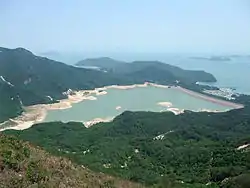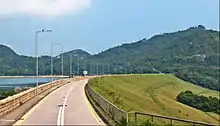Shek Pik Reservoir
Shek Pik Reservoir (Chinese: 石壁水塘) is a reservoir in Shek Pik on Lantau Island in Hong Kong. Built between 1957 and 1963, it has a storage capacity of 24 million cubic metres[1] and is the third largest reservoir in Hong Kong after High Island Reservoir and Plover Cove Reservoir.
| Shek Pik Reservoir | |
|---|---|
 | |
 Shek Pik Reservoir | |
| Location | Lantau Island, Hong Kong |
| Coordinates | 22°13′39″N 113°53′42″E |
| Type | reservoir |

Location
Shek Pik Reservoir is located within Lantau South Country Park. It is surrounded by the following areas: Kau Nga Ling (east), Keung Shan (west), Muk Yue Shan and Sz Tsz Tau Shan (north).[1] The top of the main dam is part of Keng Shan Road which connects Tai O with Cheung Sha, Mui Wo and Tung Chung. Below the dam is Shek Pik Prison managed by the Hong Kong Correctional Services.
History
In the 1950s, water became short in Hong Kong. To relieve the problem the Hong Kong Government decided to build a reservoir in Shek Pik Heung valley (石壁鄉) and to further develop Lantau Island. The main contractor for the reservoir scheme was Soletanche, a French company.
Prior to construction there were four villages, Shek Pik Tai Tseun (石壁大村), Fan Pui Tsuen (墳背村), Kong Pui Tsuen (崗貝村) and Hang Tsai Tseun (坑仔村), in the valley. They were all relocated as part of the reservoir construction.[2]
A Hau Wong Temple was located there and was inundated by the Shek Pik Reservoir in 1960.[3]
See also
- Water supply in Hong Kong
References
- "Water Supplies Department: Shek Pik Reservoir". Archived from the original on 1 February 2012. Retrieved 26 November 2011.
- "Water from a Barren Rock", Water Supplies Department
- "Distribution of temples on Lantau Island as recorded in 1979", in Journal of the Royal Asiatic Society Hong Kong Branch, Vol. 20, 1980. p.138
Further reading
- Hayes, James (2006). The Great Difference: Hong Kong's New Territories and Its People 1898-2004. Hong Kong University Press. pp. 90–96. ISBN 978-962-209-794-0.
- Hayes, James (1996). Friends & teachers: Hong Kong and its people, 1953-87. Hong Kong University Press. pp. 31–56. ISBN 978-962-209-396-6.